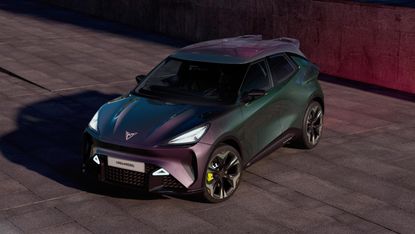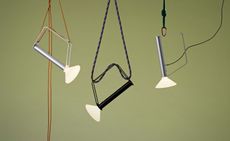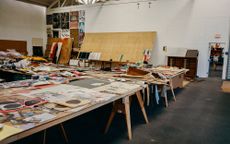Cupra design director Jorge Díez on the Spanish brand’s future: ‘Cars should express that they’re fun’
Under Jorge Díez, SEAT and Cupra are forging new, distinctive identities, encapsulating the art and emotions of driving for a new generation
- (opens in new tab)
- (opens in new tab)
- (opens in new tab)
- Sign up to our newsletter Newsletter

Jorge Díez oversees Spanish auto brands SEAT and Cupra. A long-time Wallpaper* reader, the designer has a full portfolio of future models on the boards. Born in Galicia, Díez studied industrial design, but retained a keen interest in fashion, graphics and transportation design. ‘For me, the car is an object that combines everything,’ he says, describing how he had to move to London’s RCA in order to explore all these different disciplines.

Jorge Díez Design Director of SEAT and Cupra
An early internship with Audi led to a scholarship for his second year and then a job at the German company, part of the VW Group. For Audi, he was instrumental in the design of models including the second-generation Audi TT and the first-generation Audi A7. Díez then moved to SEAT, also part of VW, where he led the Exterior Design Department at the beginning of the last decade.

Díez showcases the Cupra UrbanRebel concept at the company’s Impulse event
Back at SEAT since 2019, Díez has been part of the team overseeing the creation of the new standalone Cupra brand. Previously, the ‘Cupra’ designation was applied to sportier versions of SEAT’s model range, but by transforming the sub-brand into its own identity, the VW Group has given itself another outlet for expressive design in the burgeoning EV market.

‘There hadn’t been a new brand in the European market for many years,’ says Díez. ‘It was a good opportunity to get into a higher market position.’ The origins of the SEAT brand lie in post-war Spain, when it was founded in 1950 as the country’s national motor manufacturer, owned in part by the Spanish government and Italian industrial stalwart Fiat. The first SEATs were re-badged Fiats, and it wasn’t until 1986 that the company was taken on by VW.

Cupra arrives unburdened by this heritage, which has left SEAT with a lingering image of a hot-blooded people’s car, the emotional counterpart to the strictly rational Volkswagen. There are national stereotypes at play here, of course, but when has a carmaker ever missed the opportunity to emphasise these?
For Díez, the new brand was ‘a white sheet of paper’, and he admits that from the outset, Cupra embodied ‘some element or spirit of the country, a bit more emotion’. ‘Cupra doesn’t have to be liked by everyone, he says, ‘but a few people will really love it.’

While the current range still includes ‘hot’ versions of SEAT’s Leon and Ateca, there are also two unique Cupra-badged cars, the compact Formentor crossover and the new Born, which takes VW’s ID3 platform and gives it slightly more of an edge.
There have also been three key concept cars in the Cupra journey to date, the Tavascan electric SUV, the Terramar, a larger, plug-in hybrid SUV, and the Cupra UrbanRebel, a compact electric city car. The last is due in 2025, and the first two in 2024.

The forthcoming Cupra range: Tavascan, Terramar and UrbanRebel
One of Díez’s tasks has been to consolidate Cupra’s image. ‘We try to give each car its own personality,’ he says. ‘We would lose a bit of the effect if they all looked the same. Instead, they’re like brothers and sisters.’ Key elements, like the triangular graphic on the lights, front and rear, the slash-like creases in the bodywork, and the use of signature matte colours with copper detailing, all set the company apart and imbue a sophisticated, sporty image. In comparison to SEAT’s universal, Desigual- or Mango-like mass-market appeal, Cupra is technical sportswear.

Cupra UrbanRebel's interior
These impressions matter in a market awash with change. ‘We believe that the cars should express that they’re fun to drive,’ says Díez, arguing that the shift to EVs is a big opportunity. ‘Some brands become a bit calmer when they go electric,’ he says. ‘For us, it was all about emotions. My ultimate target is to create a sense of desire.’

Cupra Tavascan Concept
For all the talk of emotive design, Díez is frank that being part of the VW Group gives a relatively small brand like Cupra a huge advantage. ‘Being in the group means we have many possibilities,’ he says. ‘However, how you use the platforms is up to each brand. And platforms are far more flexible now than in the past.’

Cupra Tavascan Concept
Cupra is also not about designing outlandish concept cars that can never reach production. These days, car companies have concept engineers who work alongside the design teams to ensure that design principles dovetail with manufacturing capabilities. ‘We have to explain the importance of every time, so it’s important we’re all on the same page,’ says Díez.

Cupra Tavascan Concept interior
Ultimately, Díez’s role is to sift, sort and identify the differing demands of future customers across three brands, SEAT, Cupra, and SEAT’s burgeoning electric personal mobility brand. ‘We’re looking at the desires and influences of people who are now teenagers,’ he says, pointing out quirks of future consumers – they’re very good with their hands, but not so agile with their feet. Design is a way into these different approaches.

Cupra Tavascan Concept interior
‘It’s important to look outside the automotive world,’ he says. ‘We don’t use “classic” materials like wood or chrome, for example.’ Instead, the neutral matt colours and flashes of naked copper give Cupra its own identity, as does the overt use of recycled plastics and things like Neoprene on the seats. Díez and his team are exploring the potential of 3D-printing to add further personalisation, but the designer also stresses that modern LED lighting systems can also make each interior individual and unique.

Cupra UrbanRebel
To emphasise the sporting potential, Cupra interiors tend to be more driver-focused (‘It’s a bit egoistic,’ admits the designer), while even elements like interior smell and sound are considered. ‘For us, a designer needs to be like a sponge, capable of absorbing everything and analysing it,’ Díez says. ‘Objects can talk without words.’

Cupra UrbanRebel interior
Ultimately, it’ll be brands like Cupra that give voice to the next generation’s response to the automobile. ‘Speed and acceleration once generated emotions,’ says Díez, ‘but we’re looking to trigger those feelings in a different way. The key is the use of technology. I think Cupra is well placed to explore all these different aspects.’

Cupra UrbanRebel
Jonathan Bell has written for Wallpaper* magazine since 1999, covering everything from architecture and transport design to books, tech and graphic design. He is now the magazine’s Transport and Technology Editor. Jonathan has written and edited 15 books, including Concept Car Design, 21st Century House, and The New Modern House. He is also the host of Wallpaper’s first podcast.
-
 Portable lights to illuminate your winter nights
Portable lights to illuminate your winter nightsThe best portable lights and where to buy them: brighten up your winter evenings with this edit of portable lamps for your desk, garden and more
By Rosa Bertoli • Published
-
 Last chance to see: Sterling Ruby’s ‘Turbines’ at Gagosian New York, marked here by our visit to the artist’s LA studio
Last chance to see: Sterling Ruby’s ‘Turbines’ at Gagosian New York, marked here by our visit to the artist’s LA studioStep inside American artist Sterling Ruby’s studio, divided into distinct areas of operation
By Hunter Drohojowska-Philp • Published
-
 The Fendi factory in Tuscany disappears into the landscape
The Fendi factory in Tuscany disappears into the landscapeThe new Fendi Factory in Italy, set in the rolling hills of Tuscany, is the brainchild of Milan architecture studio Piuarch and the luxury brand
By Ellie Stathaki • Published


